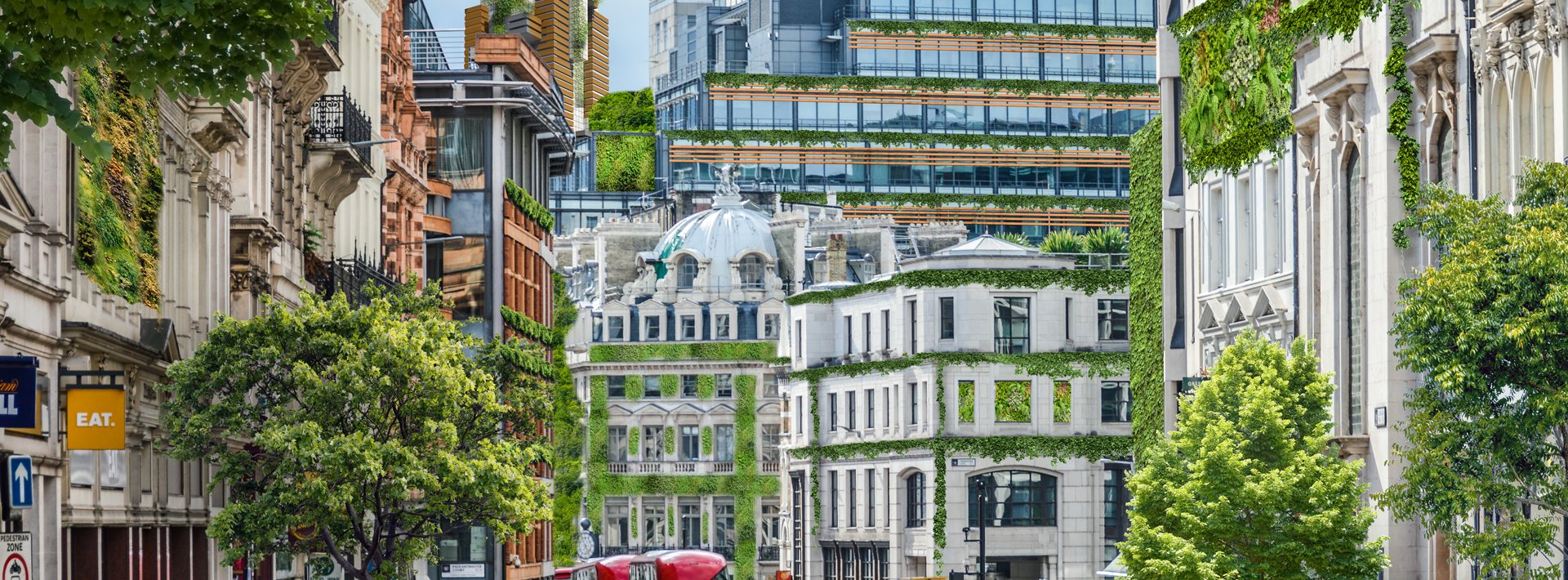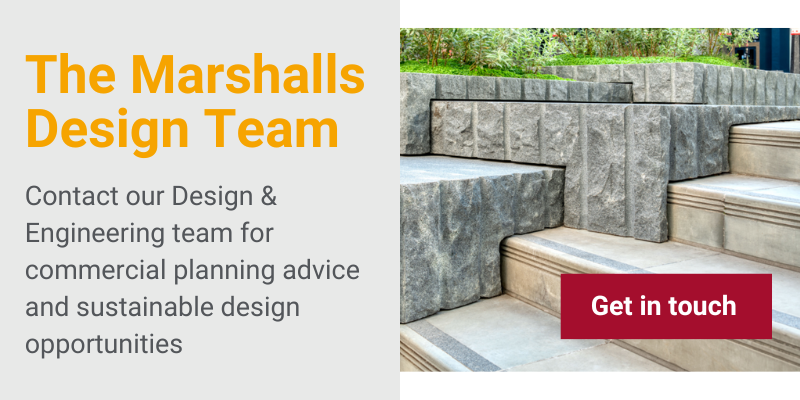Blog
According to the United Nations, the Global population is estimated to reach 9.7 billion by 2050; they also predict that 68% of the world's population will live in cities or other urban centres during the same time frame. As the world becomes more urbanised, with cities getting larger and towns growing at an exponential rate, nature is being pushed to its limits. With this in mind, as we look to shape the further development of the UK’s buildings and environments, how much emphasis should be put on incorporating ideas of biophilic design to adopt more urban greenery?
Pledges to bring more greenery into UK cities and towns
In fact, over recent years many of the UK’s cities and towns have pledged to improve their natural environment by implementing a more urban forest atmosphere. Here are a few examples;
- The 'Greener City Fund', initiated by London’s Mayor, Sadiq Khan, in 2017, aimed to transform over half of London into green spaces by 2050; a challenge indeed. The funds from this scheme have now been successfully distributed with £5 million dedicated to tree planting, £3 million to strategic infrastructure projects, £3 million to London’s urban forest project, and £1 million allocated for community engagement. This included support for events like the National Park City Festival 2019 and backing the Good Growth fund.
- In 2019, Mayor Andy Burnham launched Greater Manchester’s 'Five-Year Environment Plan' outlining an ambitious vision for a city region that is clean, carbon-neutral, and climate-resilient, all while fostering a thriving natural environment. To help make this vision a reality, the 'Greater Manchester Environment Fund' (GMEF) was established and is working to shape a greener and fairer future.
- The ‘London Plan’, adopted by the City Council in June 2016, sets out the framework for how London will develop over the next 20-25 years and the Mayor’s vision for Good Growth. Thanks to the ‘Living Roofs and Walls Policy’ included in the London Plan, a large proportion of new builds in London now feature green roofs, positioning London as a leader in green infrastructure implementation.Biophilic design
A few years ago, we revisited our 2016 'Future Spaces' research. ‘Future Spaces’ aimed to predict how commercial, public and domestic spaces might adapt and evolve over the next decade. In a world becoming increasingly urbanised, nature was expected to be ‘pushed to the fringes’ and within our ‘Future Spaces’ research, we predicted the rise of ‘Biophilic Design’. This draws inspiration from natural forms, using nature as a method to create human-friendly environments that satisfy our psychological craving for a connection to nature and help improve people's quality of life.
Back then we were initially intrigued by what was an emerging architectural/design 'fringe' discipline. Recently Biophilic Design has 'blossomed' into a way of rethinking how urban spaces can be landscaped to recreate the look, feel, and random diversity of nature.
Where previously, Biophilic Design relied on 'synthesising' the shapes and textures of nature, the concept of designing a 'second nature' for the urban environment sets landscape designers an interesting challenge, creating what biophilic theorists call 'wildness'. This is the presence of the unkempt amongst the order of the city: the transformative 'sensory shock' of seeing 'the wildness of nature bursting through the cracks of the urban'.
Those ‘shocks of nature’ are becoming less disconnected, with the wider understanding that connecting new green/blue infrastructure into existing networks brings further benefits to people and wildlife, creating fingers of green reaching towards city centres and linking parks with greener streets.
Biophilic design in practise
There’s a growing interest in incorporating greenery on building walls and rooftops to promote health, wellness and environmental benefits. We’ve seen a significant transition towards the use of natural materials and organic landscaping to recreate, rather than mimic, the shapes and beauty of nature in outdoor spaces and we’d imagined shrubs growing on the facades of buildings helping to capture the carbon dioxide, as well as producing oxygen, and an abundance of green roofs.
Amidst this flourishing green movement, it's worth noting the ‘Living Lab’ at Salford University and ‘The National Green Infrastructure Facility (NGIF)’ at Newcastle University. Here through their ‘living laboratories’ they’re actively implementing live spaces showcasing a range of Nature Based Solutions (NBS) technologies and climate mitigation solutions using real time data as evidence for the environmental and economic benefits. These living laboratories feature elements including rain gardens, living walls, green/blue roofing and sustainable urban drainage systems (SuDS) for street trees.
As awareness of the benefits of blue/green infrastructure grow and new legislation, such as the mandatory Biodiversity Net Gain comes into play (where new developments must be 10% more biodiverse after completion), the landscape may evolve.
The recent introduction of Schedule 3 of The Flood and Water Management Act 2010 signifies a shift in drainage practices, emphasising sustainable drainage systems designed to reduce the impact of rainfall on new developments by using features such as soakaways, grassed areas, permeable surfaces and wetlands. For more information see our blog, by our Design Technician, Benjamin Birkhead here.
We are positive that the biophilic trend will and needs to continue. Embracing and advancing the Biophilic trend aligns with a growing awareness of the positive impact it can have on both individuals and the broader environment, making it a crucial and enduring movement in architectural and urban planning realms.
How did we begin to imagine how this future could look?
In a piece of work a few years ago, we reimagined a number of the UKs cities with additional greenery and biophilic features.
London
The nation’s capital is jam-packed with residents, commuters and tourists, as well as some of the most impressive architectural structures. With approximately 8.8 million dwellers, as well as numerous high rises and monumental corporate buildings, bringing some greenery into the fold could really transform the city.
Imagine trees and shrubs growing on the facades of buildings helping to capture the carbon dioxide as well as producing oxygen. Not only would this bring colour and vibrance to its many main shopping areas and quirky side streets, it would also help to counteract the gasses emitted from the many cars, buses and motorcycles that grace London’s streets daily.
Glasgow
With the potential to be known as a “forest city”, the improvement to Glasgow’s overall look would be striking. With an array of walkways, bridges and paths filled with trees and shrubbery, Glaswegians could expect to feel immersed in nature from the moment they leave home, to the moment they return from work.
Birmingham
The new “capital of vertical forests”; thanks to the cities that tower over residential blocks and distinct lack of land availability, we can expect to see innovative ways of bringing more greenery to this multicultural city. Imagine tower blocks covered in vibrant green shrubbery and roof tops of buildings transformed into miniature parks and gardens; the possibilities for Birmingham are endless.
Leeds
Thanks to the city’s impressive and forward thinking architecture, some of Leeds’s spiralled buildings, designed to mimic the flow and natural forms of nature, will be adorned with plants and trees to truly emulate the power and fluidity of all things natural. Known as biomimicry, where architecture mimic natural forms, these impressive structures would be set to capture the carbon dioxide and work to produce oxygen. Not only could they counteract pollution, but they could improve the overall well-being and health of residents and visitors, too.
If you’re interested in similar commercial planning topics and sustainable design opportunities, please get in touch with our design team who can support you in bringing your vision to life:











